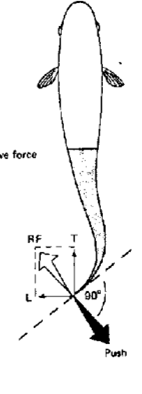Marine Vert. -- ppt 2 (Swimming)
1/43
There's no tags or description
Looks like no tags are added yet.
Name | Mastery | Learn | Test | Matching | Spaced |
|---|
No study sessions yet.
44 Terms
Aquatic animals have to overcome the force of …
drag
Terrestrial animals have to overcome the force of …
gravity
Frictional drag
friction between water and surface
What is frictional drag determined by?
smoothness (mucus production and scale shape) and surface area (body, fin shape)
T/F Frictional drag increases with velocity.
True
Pressure drag
pressure differences caused by movement
What is pressure drag determined by?
body shape
Does pressure drag increase with velocity squared?
yes
What is the muscle called that help with motion?
myomeres
What do anguilliforms use for motion?
truck and tail undulations
What are some examples of anguilliforms?
eels, dogfish, elongate sharks, larvae
T/F The head contributes to forward motion in anguilliform.
False—everything but the head is used for propulsion.

Are anguilliforms relatively slow or fast? why?
-slow due to long body
-inefficiencies of high lateral thrust
-large cross section
T/F Anguilliforms are very flexible.
True
What part of the body undulates in subcarangiform swimming?
posterior ¾ - ½ of body undulates
What are some examples of subcarangiform swimmers?
trout, salmon — many teleosts
T/F Both posterior body and tail contribute forward thrust in subcarangiforms.
True
What are some advantages to subcarangifrom swimming?
-good balance of efficiency
-speed
-maneuverability
Are subcarangiforms able to rapidly accelerate from a dead start?
yes, due to low aspect ratio tail
What part of the body undulates in carangiform swimmers?
posterior ½ - ¼ of body
T/F Carangiforms have a very flexible body.
False, they have a moderately stiff body
What part of the body is used in carangiforms?
posterior body and tail contribute to thrust—mostly the tail

Carangiforms are very fast, but what do they sacrifice to be that?
-efficiency
-maneuverability
Carangiform fish have a higher aspect ratio tail. How does this benefit them?
better for sustained high-speed swimming
What are some examples of thunniform swimmers?
mackerel sharks, billfishes, tuna
T/F Thunniforms have inflexible bodies.
true
What part of the body is used for propulsion on thunniforms?
a stiff sickle-shaped caudal fin
Does a thunniforms have a high-aspect ratio or low-aspect ratio tail? What does this help with?
High aspect ratio tail—helps with propulsion
T/F Thunniforms are very efficient and fast, but take time to accelerate from a stop.
true
what oscillations are found in ostraciiform?
tail oscillations
examples of ostraciiform swimmers.
boxfish, torpedo rays
Why do ostraciiforms only move their tails for propulsion?
electricity producing/sensing fish need to keep their body straight to sense electrical fields
Examples of organisms that are tetradontiform and balistiform
-puffers, triggerfishes, ocean sunfishes
How do tetraodontiforms and balistiforms swim?
by flapping their dorsal and anal fins synchronously
Examples of rajiforms.
skates and rays
How do rajiforms swim?
undulations along margins of pectoral fins
examples of amiiforms.
bowfin, seahorses
How do amiiforms swim?
undulations passing along dorsal fin
examples of gymnotiforms.
knife fish, featherfins
How do gymnotiforms swim?
undulations passing along the anal fin
examples of Labriforms.
chimaeras, surfperches, wrasses, parrotfish
How do labriforms swim?
rowing with pectoral fins
T/F Most elasmobranchs swim via undulations
True
How does pressure help with the swimming of sharks?
-increasing internal pressure + increasing speed = stiffening of sharks skin
-acts as secondary attachment for swimming muscles